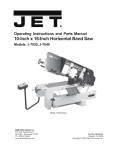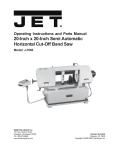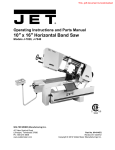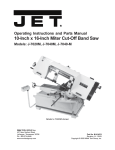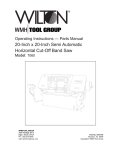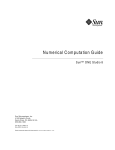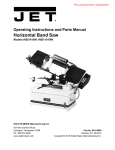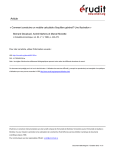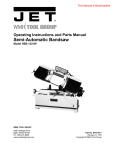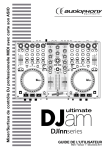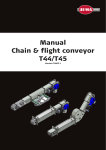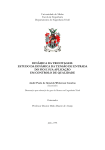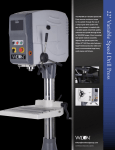Download Wilton 7020/7040 User's Manual
Transcript
Operating Instructions & Parts Manual 10-Inch x 16-Inch Horizontal Cut-Off Band Saw Models 7020/7040 Part No. 9078341 Revision C4 07/03 WMH TOOL GROUP 2420 Vantage Drive Elgin, IL 601237 TEL: 1-888-594-5866 FAX: 1-800-626-9676 www.wmhtoolgroup.com Table of Contents General Specifications ....................................................................................................................................... 5 Specifications .................................................................................................................................................... 5 General Specifications ....................................................................................................................................... 5 Machinery General Safety Warnings ................................................................................................................. 6 Operating Precautions ....................................................................................................................................... 6 General Electrical Cautions ................................................................................................................................ 7 Safety Instructions on Sawing Systems ............................................................................................................. 7 Introduction ...................................................................................................................................................... 8 Operating Instructions .................................................................................................................................... 8 Controls ............................................................................................................................................................. 8 Setting Blade Speed ........................................................................................................................................... 8 Operating Instructions ........................................................................................................................................ 8 Raising/Lowering the Saw Head ......................................................................................................................... 9 Controlling the Cut: Hydraulic Feed Control ...................................................................................................... 9 Evaluating Cutting Efficiency ............................................................................................................................. 9 Blade Selection .................................................................................................................................................. 9 Blade Break-in Procedures .............................................................................................................................. 10 Work Setup .................................................................................................................................................... 10 Securing the Workpiece for Square Cuts ........................................................................................................ 10 Adjusting the Vise for Angle Cuts ..................................................................................................................... 10 Work Set-up .................................................................................................................................................... 10 Installation and Adjustment of Work Stop .......................................................................................................... 11 Starting the Saw ............................................................................................................................................... 11 Adjustments ................................................................................................................................................... 12 Blade Tracking Adjustment ............................................................................................................................... 12 Coolant Flow .................................................................................................................................................... 12 Coolant Mixture and Quantity ........................................................................................................................... 12 Factory or Field Procedure .............................................................................................................................. 12 Adjustments ..................................................................................................................................................... 12 Blade Guide Bearing Adjustment ...................................................................................................................... 13 Test Cutting to Verify Adjustment Accuracy ...................................................................................................... 14 Adjustment of the Limit Switch .......................................................................................................................... 14 Maintenance ................................................................................................................................................... 14 Cleaning .......................................................................................................................................................... 14 Lubrication ....................................................................................................................................................... 14 Maintenance .................................................................................................................................................... 14 Changing Blades .............................................................................................................................................. 15 Changing the Drive Belt ................................................................................................................................... 15 Replacing the Drive Motor ................................................................................................................................ 15 Adjusting the Counterbalance Spring ............................................................................................................... 15 Replacing the Drive Wheel ............................................................................................................................... 16 Adjusting the Blade Guides .............................................................................................................................. 16 Replacement of Carbide Blade Guide .............................................................................................................. 16 Replacement of Guide Bearings ....................................................................................................................... 17 Replacement of Blade Edge Bearings .............................................................................................................. 17 Replacement of the Wire Brush ....................................................................................................................... 17 Machine Setup ............................................................................................................................................... 17 Uncrating and Spotting ..................................................................................................................................... 17 Electrical .......................................................................................................................................................... 18 Wiring Diagrams .............................................................................................................................................. 18 Troubleshooting ............................................................................................................................................. 20 3 Table of Contents Replacement Parts ........................................................................................................................................ 21 Parts List - Base .............................................................................................................................................. 23 Parts List - Head .............................................................................................................................................. 27 4 General Specifications The Wilton Models 7020/7040 Horizontal Cut-Off Bandsaws are ruggedly built, precision machines designed for either wet or dry applications. The 2 HP motor along with the worm gear reduction drive train in an oil bath, transmits smooth and positivepower to the blade. This drive system coupled with the recirculating coolant system keeps the blade running cool and true, which results in longer blade life. Specifications Capacity 10" Round 10" x 10" Square 9" x 16" Rectangle Speeds 100 to 350 feet per minute - variable speed Motor Model 7020 - 1.5 H.P., 1 phase, 110/220V Model 7040 - 2 H.P., 3 phase, 220/440V Blade Size 1" x .035" x 135" Blade Guides Adjustable 6 point contact combination bearing and carbide Blade Wheels 14" diameter, cast iron Dimensions Length: 79" / Width: 31" / Height: 41" Shipping Weight Approximately 725 pounds Vise Rapid acting, 3 jaw design Coolant System Recirculating system standard with each machine complete with 1 GPM pump, 8 gallon reservoir, and coolant applied through the blade guides. 5 - Misuse of this machine can cause serious injury. - For safety, machine must be set up, used and serviced properly. - Read, understand and follow instructions in the Operating Instructions and Parts Manual which was shipped with your machine. When Setting up Machine: - Always avoid using machine in damp or poorly lighted work areas. - Always be sure the machine support is securely anchored to the floor or the work bench. When Using Machine: - Always wear safety glasses with side shields (See ANSI Z87.1) - Never wear loose clothing or jewelry. - Never overreach - you may slip and fall. When Servicing Machine: - Always disconnect the machine from its electrical supply while servicing. - Always follow instructions in Operating Instructions and Parts Manual when changing accessory tools or parts. - Never modify the machine without consulting Wilton Corporation. You - the Stationary Power Tool User - Hold the Key to Safety. Read and follow these simple rules for best results and full benefits from your machine. Used properly, Wilton’s machinery is among the best in design and safety. However, any machine used improperly can be rendered inefficient and unsafe. It is absolutely mandatory that those who use our products be properly trained in how to use them correctly. They should read and understand the Operating Instructions and Parts Manual as well as all labels affixed to the machine. Failure in following all of these warnings can cause serious injuries. Machinery General Safety Warnings 6 1. Always wear protective eye wear when operating machinery. Eye wear shall be impact resistant, protective safety glasses with side shields which comply with ANSI Z87.1 specifications. Use of eye wear which does not comply with ANSI Z87.1specifications could result in severe injury from breakage of eye protection. 2. Wear proper apparel. No loose clothing or jewelry which can get caught in moving parts. Rubber soled footwear is recommended for best footing. 3. Do not overreach. Failure to maintain proper working position can cause you to fall into the machine or cause your clothing to get caught pullingyou into the machine. 4. Keep guards in place and in proper working order. Do not operate the machine with guards removed. 5. Avoid dangerous working environments. Do not use stationary machine tools in wet or damp locations. Keep work areas clean and well lit. 6. Avoid accidental starts by being sure the start switch is OFF before plugging in the machine. 7. Never leave the machine running while unattended. Machine shall be shut off whenever it is not in operation. 8. Disconnect electrical power before servicing. Whenever changing accessories or general maintenance is done on the machine, electrical power to the machine must be disconnected before work is done. 9. Maintain all machine tools with care. Follow all maintenance instructions for lubricating and the changing of accessories. No attempt shall be made to modify or have makeshift repairs done to the machine. This not only voids the warranty but also renders the machine unsafe. 10. Machinery must be anchored to the floor. 11. Secure work. Use clamps or a vise to hold work, when practical. It is safer than using your hands and it frees both hands to operate the machine. 12. Never brush away chips while the machine is in operation. 13. Keep work area clean. Cluttered areas invite accidents. 14. Remove adjusting keys and wrenches before turning machine on. 15. Use the right tool. Don’t force a tool or attachment to do a job it was not designed for. 16. Use only recommended accessories and follow manufacturers instructions pertaining to them. 17. Keep hands in sight and clear of all moving parts and cutting surfaces. 18. All visitors should be kept at a safe distance from the work area. Make workshop completely safe by using padlocks, master switches, or by removing starter keys. 19. Know the tool you are using — its application, limitations, and potential hazards. General Electrical Cautions This saw should be grounded in accordance with the National Electrical Code and local codes and ordinances. This work should be done by a qualified electrician. The saw should be grounded to protect the user from electrical shock. Conductor Length 0 - 50 Feet 50 - 100 Feet Over 100 Feet Wire Sizes Caution: For circuits which are far away from the electrical service box, the wire size must be increased in order to deliver ample voltage to the motor. To minimize power losses and to prevent motor overheating and burnout, the use of wire sizes for branch circuits or electrical extension cords according to the following table is recommended. AWG (American Wire Gauge) Number 240 Volt Lines 120 Volt Lines No. 14 No. 14 No. 14 No. 12 No. 12 No. 8 Safety Instructions on Sawing Systems 1. Always wear leather gloves when handling saw blade. The operator shall not wear gloves when operating the machine. 2. All doors shall be closed, all panels replaced, and other safety guards in place prior to the machine being started or operated. 3. Be sure that the blade is not in contact with the workpiece when the motor is started. The motor shall be started and you should allow the saw to come up to full speed before bringing the saw blade into contact with the workpiece. 4. Keep hands away from the blade area. See Figure A. 5. Remove any cut off piece carefully while keeping your hands free of the blade area. 6. Saw must be stopped and electrical supply must be cut off before any blade replacement or adjustment of blade support mechanism is done, or before any attempt is made to change the drive belts or before any periodic service or maintenance is performed on the saw. 7. Remove all loose items and unnecessary workpieces from the area before starting machine. 8. Bring adjustable saw guides and guards as close as possible to the workpiece. A B 9. Always wear protective eye wear when operating, servicing, or adjusting machinery. Eyewear shall be impact resistant, protective safety glasses with side shields complying with ANSI Z87.1 specifications. Use of eye wear which does not comply with ANSI Z87.1 specifications could result in severe injury from breakage of eye protection. See Figure B. 10. Nonslip footwear and safety shoes are recommended. See Figure C. 11. Wear ear protectors (plugs or muffs) during e x tended periods of operation. See Figure D. 12. The workpiece, or part being sawed, must be securely clamped before the saw blade enters the workpiece. 13. Remove cut off pieces carefully, keeping hands away from saw blade. 14. Saw must be stopped and electrical supply disconnected before reaching into cutting area. 15. Avoid contact with coolant, especially guarding your eyes. C D 7 Introduction This manual includes the operating and maintenance instructions for the Wilton 10-inch by 16-inch Cut Off Band Saw, Models 7020/7040. This manual also includes parts listings and illustrations of replaceable parts. Operating Instructions Controls The operating controls for the saw are provided in a control panel on the left side of the machine. The control panel is mounted on a pivoting tube. The pivoting tube allows the operator to position the control panel in a convenient location. Power-on Light Motor Pushbutton Emergency Reset Button Saw Head Pushbutton Figure 1: Control panel 8 1. A power-on light is provided on the left side of the control panel. The power-on light indicates when power is connected to the machine. 2. A n emergency stop button is provided on the control panel. The emergency stop button provides a means to rapidly cut off electrical power. 3. The saw motor pushbutton switch starts the saw motor and the E-stop button stops the saw motor. 4. A green pushbutton switch is provided to the right of the emergency stop pushbutton. The pushbutton opens an electro-magnetic valve in the hydraulic cylinder circuit. Opening the valves allows the saw head to move downward and put the saw blade in contact with the workpiece. 5. A red release button on the electro-magnetic valve provides a means to lower the saw head when power to the machine has been disconnected (see figure 4). 6. The rate at which the saw head moves downward is controlled by a hydraulic feed rate control located on the top, rear of the saw head (see figure 3). 7. A coolant pump switch is provided on the electrical equipment box on the back of the machine Setting Blade Speed 1. The blade speed is controlled by an adjustment mechanism on the right end of the saw. Speed increases when the adjustment knob is turned counterclockwise. Speed decreases when the knob is turned clockwise. 2. A placard on the drive belt guard provides recom mended speeds for various materials. 3. A speed indicator is provided on the barrel of the adjustment mechanism. The indicator provides speed indications in feet per minute and meters per minute. (The meters per minute values are shown in parenthesis on the indicator.) 4. The feed rates on the placard are expressed in meters per minute. The feed rate graduations available on the indicator may not match the recommended feed rate. An approximate speed may therefore be required. For example, to set a speed rate of 25 meters per minute, the indicator would be set about midway between 21 metersper-minute and the 30 meters-per-minute graduations. WARNING: TO CHANGE SPEED, THE SAW MOTOR MUST BE OPERATING. 5. Turn the speed adjustment knob to the desired rate setting as determined by the material being cut. Coolant Pump Switch Figure 2: Coolant pump switch Raising/Lowering the Saw Head 1. Lift the saw head using the handle on the far left side of the saw head. 2. To lower the saw head, press the green pushbutton on the right side of the control panel. 3. To adjust the feed rate, adjust the feed rate control valve knob on the top of the saw head (see figure 3). 4. To lower the saw head with power off, pull and turn the red knob (manual override) on the electro-magnetic valve (see figure 4). Controlling the Cut: Hydraulic Feed Control Blade Tensioning Hand Wheel Blade Guide Saw Head Supports Feed Rate Control Saw Head Saw Head Lift Handle Vise Clamping Hand Wheel Speed Control Blade Drive Motor Figure 3: Controls ElectroMagnetic Valve Figure 4: Lowering head with power off The weight of the saw arm provides all the force needed to move the saw blade through the workpiece. In fact, if the full weight of the arm is allowed to make the cut, rapid blade wear and poor cutting accuracy will result. A hydraulic feed control is provided that gives the operator a means to control the speed and efficiency of cutting. The hydraulic cylinder is attached between the saw base and the saw head. The hydraulic cylinder resists movement of the saw head in the downward direction. However, the hydraulic cylinder offers no resistance when the saw head is raised upward. The amount of downward force can be controlled by using the feed rate control valve. When the valve is opened slightly, the saw head will move downward. The further the valve is opened, the faster the saw head will move downward. The feed control is adjusted by the operator until the saw is operating efficiently. This is usually determined by observing the chip formation. (See Evaluating Blade Efficiency for more information on cutting efficiency.) Control Box Red Release Button Belt Cover Evaluating Cutting Efficiency Is the blade cutting efficiently? The best way to determine this is to observe the chips formed by the cutting blade. If the chip formation is powdery, then the feed rate is much too light, or the blade is dull. If the chips formed are curled, but colored — that is, either blue or straw-colored from heat generated during the cut — then the feed rate is too high. If the chips are slightly curled and are not colored by heat — the blade is sufficiently sharp and is cutting at its most efficient rate. Blade Selection The cut-off saw is provided with a saw blade that is adequate for a variety of cut-off jobs on a variety of common materials. A 4/6 vari tooth bi-metal blade (5674011) and a 6/10 vari tooth bi-metal blade (5674021) are available from Wilton. See Setting Blade Speed for the speeds recommended for various materials. These selections, while appropriate for many shop cutting needs, do not encompass the wide variety of blades of special configuration (tooth pitch and set) and special alloys for cutting unusual or exotic materials. A coarse blade could be used for a solid steel bar but a finer tooth blade would be used on a thin-wall tube. In general, the blade choice is determined by the thickness of the material; the thinner the material, the finer the tooth pitch. 9 A minimum of three teeth should be on the work piece at all times for proper cutting. The blade and workpiece can be damaged if the teeth are so far apart that they straddle the workpiece. For very high production on cutting of special materials, or to cut hard-to-cut materials such as stainless steel, tool steel, or titanium, you can ask your industrial distributor for more specific blade recommendations. Also, the supplier who provides the workpiece material should be prepared to provide you with very specific instructions regarding the best blade (and coolant or cutting fluid, if needed) for the material and shape supplied. Blade Break-in Procedures New blades are very sharp and, therefore, have a tooth geometry which is easily damaged if a careful break-in procedure is not followed. Consult the blade manufacturer’s literature for break-in of specific blades on specific materials. However, the following procedure will be adequate for break-in of Wilton-supplied blades on lower alloy ferrous materials. 1. Clamp a round section workpiece in the vise. The workpiece should be 2 inches or larger in diameter. 2. Set the saw on low speed. Start the cut with a very light feed rate. 3. When the saw has completed 1/3 of the cut, increase the feed rate slightly and allow the saw to complete the cut. 4. Keep the same hydraulic cylinder setting and begin a second cut on the same or similar workpiece. 5. When the blade has completed about 1/3 of the cut, increase the feed rate. Watch the chip formation until cutting is at its most efficient rate and allow the saw to complete the cut (see Evaluating Blade Efficiency). The blade is now considered ready for regular service. 10 Work Setup Securing the Workpiece for Square Cuts 1. Raise the saw head (refer to Figure 5). 2. Slide the left vise jaw far enough to the left to allow the workpiece to be placed in the vise. 3. Place the workpiece on the work table. If the workpiece is long, provide support at the other end. It may also be necessary to provide additional downward clamping to hold the workpiece securely on the work table. 4. Turn clamping hand wheel clockwise to clamp the workpiece in position against the fixed (right) vise jaw. 5. After completing the cut, turn the clamping hand wheel counterclockwise and slide the left jaw away from the workpiece. Clamping Hand Wheel Left Vise Jaw Saw Head Work Table Figure 5: Securing workpiece Adjusting the Vise for Angle Cuts 1. Referring to Figure 5, loosen the angle locking screw and the pivot screw on the left vise jaw. 2. Turn the locking handle on the round, angle-setting block counterclockwise to unlock the block. Slide the block until the pointer on the block is aligned with desired angle (see figure 7). Tighten the locking handle to set the angle. 3. Set the workpiece in the vise. Put the front end of the workpiece against the corner of the right vise jaw. Put the rear end of the workpiece against the angle-setting block. 4. Turn clamping hand wheel clockwise until the left vise jaw is parallel with the workpiece. Tighten the pivot screw and angle locking screw on the left vise jaw. Clamp the workpiece in position. 5. After completing the cut, turn the clamping hand wheel counterclockwise and slide the left jaw away from the workpiece. Angle Setting Block place it against the work piece. Set Workpiece Against Corner of Right Vise Jaw Starting the Saw Left Vise Jaw Pivot Screw Angle Locking Screw WARNING: NEVER OPERATE THE SAW WITHOUT BLADE COVERS IN PLACE AND SECURED. CAUTION: MAKE SURE THE BLADE IS NOT IN CONTACT WITH THE WORKPIECE WHEN THE MOTOR IS STARTED. DO NOT DROP THE SAW HEAD ON THE WORKPIECE OR FORCE THE SAW BLADE THROUGH THE WORKPIECE. Figure 6: Adjusting vise Angle Block Locking Handle Angle Pointer Figure 7: Angle setting block Installation and Adjustment of Work Stop Figure 5: Securing workpiecThe work stop is used to set up the saw for making multiple cuts of the same length (see figure 8). Install and adjust the work stop as follows: Stop Post 1. Raise the saw head. With the saw motor off, pull the red release button on the electro-magnetic valve and check the rate at which the saw head lowers. 2. Raise the saw head. Push in red release button. 3. Clamp the workpiece in the vise. (See figure 9 for examples of workpieces in the vise.) 4. Be sure the blade is not in contact with the workpiece when the motor is started. 5. Start the motor and allow the saw to come up to speed. 6. Slowly set the saw down onto the workpiece. Adjust cutting speed with feed rate control valve. 7. DO NOT DROP THE SAW HEAD OR FORCE THE CUT. Let the weight of the saw head provide the cutting force. 8. The saw will automatically shut off at the end of the cut. Locking Lever Rounds "Wing" Screw Stop L-Bracket Knob Flats/strips Stop Rod Knock off sharp f f edge here with f file Figure 8: Work stop 1. Insert the end of the stop rod in the hole in the front right side of the work table. 2. Tighten the “wing” screw to secure the rod in place. 3. Install the stop post in the channel on the back of the stop L-bracket. Install the locking lever in the threaded hole in the stop post. Snug-up the locking lever. 4. Install the locking knob in the hole in the side of the stop L-bracket. 5. Slide the assembled stop L-bracket onto the stop rod. Position the stop post against the work piece and tighten the knob in the stop L-bracket. The stop post can be moved left or right as required to Channels Squares/rectangles Hexagonals I-Beams Angles Knock off sharp f edge here with file f Tees Figure 9: Placing workpieces in the vise 11 Coolant Flow CAUTION: THE COOLANT PUMP MUST BE SUBMERGED BEFORE OPERATING TO PREVENT DAMAGE TO THE PUMP. 1. The blade guides are fitted with coolant fittings. Coolant is provided to the fittings through interconnecting tubing. The coolant is dispensed directly onto the saw blade. 2. Adjust the coolant flow valves on the top, rear of the saw head as required to provide the desired flow. The flow should be no more than the blade can draw into the workpiece by blade movement. 3. The coolant flow can be stopped in two ways: 1) By using the coolant pump switch on the electrical equipment box, or 2) By closing the coolant flow valves on the top, rear of the saw head. Coolant Mixture and Quantity The general purpose coolant is a mixture of water soluble oil and water. Mix one part of soluble oil (TRIM SOL) to ten parts of water (one quart oil, ten quarts of water). Eleven quarts of coolant are required for the coolant pump to operate properly. There are numerous coolants on the market that are formulated for special applications. Consult your local distributor for details in the event you have a long range production task, or are required to cut some of the more exotic materials. Adjustments 12 The efficient operation of the cut-off saw is dependent upon the condition of the saw blade. If the performance of the saw begins to deteriorate, the first item that you should check is the blade. If a new blade does not restore the machine’s cutting accuracy and quality, refer to the Troubleshooting section (or the blade manufacturer’s guide) for conditions to consider and adjustments that can be made to increase the life of the blade. To change the blade, refer to Changing Blades in the Maintenance section. To adjust the blade tracking, refer to the following procedures. Blade Tracking Adjustment Blade tracking has been tested at the factory. Adjustment is rarely required when the blade is used properly or if the blade is correctly welded. (See figure 10 for location of blade tracking adjustment screws.) Blade Tracking Hex Adjustment Screws Single Adjustment Screw Center Locking Screws Figure 10: Blade tracking and tensioning Factory or Field Procedure 1. Raise the saw head enough to allow the saw motor to operate. 2. Loosen four knobs securing the blade cover. Lift the cover and swing it backward. 3. Remove the blade guard mounted on the left blade guide support. 4. Remove both blade guide bearing brackets. NOTE: Maintain proper tension at all times using the blade tensioning mechanism. 5. Loosen the center locking screws in all three hex adjustment screws on the blade tensioning mechanism (see figure 10). CAUTION: WHILE PERFORMING THE FOLLOWING, KEEP THE BLADE FROM RUBBING EXCESSIVELY ON THE SHOULDER OF THE WHEEL. EXCESSIVE RUBBING WILL DAMAGE THE WHEEL AND/OR THE BLADE. 6. Start the saw. Slowly turn the single hex adjustment screw at the rear of the tracking mechanism to tilt the idler wheel. Do not turn either of the other two adjustment screws. Turn the adjustment screw until the blade is touching the shoulder of the idler wheel. NOTE: Turning the screw inward causes the blade to move toward the shoulder of the wheel. Turning the screw outward causes the blade to move away from the shoulder. 7. Turn the single hex adjustment screw so the blade starts to move away from the shoulder of the wheel — then turn the single hex adjustment screw in the other direction so the blade stops, then moves slowly toward the shoulder. WARNING: KEEP FINGERS CLEAR OF THE BLADE AND WHEEL TO AVOID INJURY. 8. Turn the single hex adjustment screw to stop the motion of the blade on the wheel as it gets closer to the wheel shoulder. Put a 6-inch length of paper between the blade and the wheel as shown in figure 11. The paper should not be cut as it passes between the wheel shoulder and the blade. 9. Turn the single hex adjustment screw a small amount. Repeat the insertion of the paper between the wheel shoulder and the blade until the paper is cut in two pieces. NOTE: You may have to repeat the check with the paper several times before the blade and the shoulder cuts the paper into two pieces. Do not hurry the adjustment. Patience and accuracy here will pay off with better, more accurate, quieter cutting and much longer machine and blade life. 10. When the paper is cut, turn the hex adjustment screw slightly in the counterclockwise direction. This assures that the blade is not touching the shoulder of the wheel. 11. Shut off the saw. 12. Hold the hex adjustment screws with a wrench and tighten the center locking screws. Make sure the hex adjustment screws do not move while tightening the center screws. 13. Install the two blade guide bearing brackets. Position the guides so the bearings just touch the blade. 14. Install the left blade guard. 15. Close the saw head cover. Tighten all four knobs. Motor "ON" Upper Wheel Rotating should rarely require adjustment. When adjustment is required, adjust immediately. Failure to maintain proper blade adjustment may cause serious blade damage or inaccurate cuts. It is always better to try a new blade when cutting performance is poor. If performance remains poor after changing the blade, make the necessary adjustments. If a new blade does not correct the problem, check the blade guides for proper spacing. For most efficient operation and maximum accuracy, provide 0.001 inch clearance between the blade and the guide bearings. The bearings will still turn freely with this clearance. If the clearance is incorrect, the blade may track off the drive wheel. CAUTION: CHECK THE BLADE TO MAKE SURE THE WELDED SECTION IS THE SAME THICKNESS AS THE REST OF THE BLADE. IF THE BLADE IS THICKER AT THE WELD, THE GUIDE BEARINGS MAY BE DAMAGED. If required, adjust the guide bearings as follows: 1. The inner guide bearing is mounted on a concentric bushing and can not be adjusted. 2. The outer guide bearing (closest to the operator) is mounted on an eccentric bushing and can be adjusted. 3. Hold the bushing with a 3/4-inch wrench and loosen Guide Bracket Eccentric Bushing Locking Screw Put Strip Between Wheel and Blade Blade Outer Roller (Blade Guide Roller) Figure 12: Adjustment of guide bearings INCORRECT Outer Roller CORRECT Inner Roller Figure 11: Checking blade-to-wheel clearance using paper strips Blade Guide Bearing Adjustment Proper adjustment of the blade guide bearings is critical to efficient operation of the cut-off saw. The blade guide bearings are adjusted at the Factory. They Blade Locking Screw Figure 13: Blade -to-bearing orientation 13 the center locking screw with an Allen wrench (see figure 12). 4. Position the bearing by turning the bushing. Set the clearance at approximately 0.001 inch. (The blade should be in a vertical position between the bearings. (See figure 13.) 5. Tighten the center locking screw with an Allen wrench while holding the eccentric bushing in position with the 3/4-inch wrench. 6. Use the same procedure to adjust the other guide bearing. 7. When the adjustment is correct, the guide bearings should rotate freely with slight pressure of the finger (with the blade stopped). 8.Adjust blade-edge bearings so they just touch the back edge of the blade (see figure 19). Test Cutting to Verify Adjustment Accuracy Test cuts can be used to determine whether or not you have adjusted the blade accurately. Use 2-inch round bar stock to perform these test cuts, as follows: 1. With the bar stock securely clamped in the vise, make a cut through the bar stock. (See figure 14.) 2. Mark the top of the bar stock. 3. Move the bar stock about 1/4-inch past the blade so you can begin a second cut. 4. Rotate the bar stock 180 degrees so the mark you made is now at the bottom of the cut. 5. Make a cut through the bar stock. 6. Use a micrometer to measure the thickness varia1. Clamp in vise and mark top of barstock here 2. Cut off a slice of the bar stock 14 3. Rotate stock in vise so mark is at bottom 4. Cut off a new slice from the stock 5. Measure here... New slice 6. ...measure here 7. Differences between measurements at edges of disc should be less than .003 inches per inch per side of stock diameter Figure 14: Cutting a test disc tion of the disk you have cut from the bar stock. Measure at the top and bottom of the disk. The saw blade can be considered correctly adjusted when the variation measure is no more than 0.012 inch across the face of the disk. If you do not have a piece of 2-inch bar stock available for a test cut, use a larger diameter test piece rather than a smaller one. The maximum thickness variation on any test piece should be no more than 0.003 inch, per side, per inch of stock diameter. Adjustment of the Limit Switch 1. The limit switch is provided to shut off the saw motor when the workpiece is cut through. 2. To set the limit switch, loosen the jam nut on the limit switch stop (figure15). 3. Adjust the stop as required and retighten jam nut. Jam Nut Adjustment Screw Switch Roller Limit Switch Figure 15: Limit switch adjustment Maintenance Cleaning 1. Clean off any preservative on machine surfaces. 2. After cleaning, coat the machined surfaces of the cut-off saw with a medium consistency machine oil. Repeat the oil coating process at least every six months. 3. Clean up accumulated saw cuttings after use. Make sure the lead screw is kept free of saw cuttings and other material that would cause damage. 4. Clean the chip sludge from the coolant tank. The frequency should be determined by how often the saw is used. Lubrication Lubricate the following components at the specified frequencies and using the lubricants as defined: 1. Ball bearings: the bearings are lubricated and sealed—periodic lubrication is not required. 2. Blade guide bearing: the bearings are lubricated and sealed—lubrication is not required. Inspect periodically. 3. Idler wheel bushing: the bearings are lubricated and sealed—lubrication is not required. Inspect periodically. 4. Lead screw bearing housing: lubricate with light oil monthly (see exploded figure, page 20). 5. Lead screw: lubricate with light oil monthly (see exploded figure, page 20). 6. Hydraulic cylinder pivot: lubricate with light oil every 6 months (see exploded figure, page 20). 7. Blade tension screw: lubricate with grease every 6 months (see exploded figure, page 24). 8. Blade brush bearing: lubricate with light oil monthly (see exploded figure, page 24). 9. Gear box: check oil once a year. 10. Change coolant on a frequency appropriate to the type of coolant being used. Oil based coolants can sour. Refer to the coolant supplier’s instructions for change frequency. 11. Coolant tank: clean every 6 months or as required. Changing Blades WARNING: SHUT OFF ALL ELECTRICAL POWER TO THE MACHINE. 1. Loosen four knobs securing the blade cover. Lift the cover and swing it backward. 2. Remove the blade guard mounted to the left blade guide support. WARNING: ALWAYS WEAR LEATHER GLOVES WHEN HANDLING SAW BLADE TO AVOID INJURY FROM THE SAW TEETH. 3. Turn the blade tensioning hand wheel clockwise to relieve tension on the blade. Loosen the blade enough to remove the blade from the idler and drive wheels. Remove the blade from between the blade guides. 4. Install the new blade between the blade guide bearings and the carbide blade guides. Install the blade over the drive and idler wheels. 5. Turn the blade tensioning hand wheel counterclockwise to tighten the blade. Tighten the blade until the blade tension indicator reads 2000 pounds. 6. Operate the saw at low speed and observe the tracking of the blade. If tracking needs to be adjusted, refer to Blade Tracking Adjustment. 7. Adjust the bearings on the upper edge of the blade until they just contact the blade (see figure 19). 8. Check the guide bearings and the carbide guides to make sure they are just contacting the sides of the blade. 9. Install the left blade guard making sure there is ample clearance with the blade. 10. Make a test cut to make sure the blade tracks properly during operation. Adjust tracking as required (see Blade Tracking Adjustment). Changing the Drive Belt 1. Disconnect the electrical power source from the cut-off saw to prevent any possibility of accidental motor start-up. 2. Set the arm at the full horizontal position. 3. Remove the knob on the drive belt cover. Remove the drive belt cover to expose the V-belt and pulleys. 4. Remove two screws, nuts, and washers from back of saw head support. Push on the motor support bracket to pivot the motor upward to loosen the tension on the belt. 5. Remove the worn belt. 6. Put the replacement belt in the pulleys. Allow the motor to pivot downward. 7. Install the two screws, nuts, and washers in back of saw head support and through the motor support bracket. 8. Install the drive belt cover. Install and tighten the knob on the drive belt cover. Replacing the Drive Motor 1. Disconnect the motor from all electrical power. Unplug the motor if it is plugged into a socket. Shut off the power to the branch and remove the connection to the junction box if the motor is hard wired to the branch. 2. Remove the drive belt from the drive motor pulley (see Changing the Drive Belt). 3. Remove motor pulley. 4. Open the motor junction box and disconnect the power cord wires from their terminals. 5. Remove the nuts, washers and bolts that secure the motor to the mounting plate. 6. Installation of a new motor is a reversal of the above steps. Adjusting the Counterbalance Spring The counterbalance spring is located at the right, rear of the saw head. The counterbalance spring is 15 Pivot Adjustment Nuts 5. 6. 7. 8. Threaded Rod Counterbalance Spring Figure 16: Counterbalance spring adjustment used to adjust the amount of down force the saw head puts on the workpiece when the feed rate control valve is fully open. 1. Raise the saw arm to its full upright position and lock it in position. 2. To adjust the tension on the spring, loosen the two nuts on the threaded rod of the spring pivot post. Adjust the tension as required. 3. Tighten the two nuts against the pivot post. 4. The saw can now be returned to service. damaged. Inspect bearings for damage and smooth operation, Replace if faulty. Install the bearing in the idler wheel. Install the idler wheel on the idler shaft. Install the screw, spring washer and washer in the idler shaft. Install the blade (see Changing blades). Adjusting the Blade Guides The cut-off saw has adjustable blade guide supports (see figure 17). The blade guide supports allow you to set the blade guides for varying widths of workpieces. To make accurate cuts and prolong blade life, the blade guide supports should be set to just clear the workpiece to be cut. Blade Guide Supports Replacing the Drive Wheel 16 1. Remove the blade (see Changing Blades). 2. Remove the screw, spring washer, and washer from the speed reducer shaft. 3. Pull the wheel from the speed reducer shaft. Remove the drive key from the speed reducer shaft. 4. Inspection: Examine drive edge and shoulder of the wheel for damage. Replace the wheel if damaged. 5. Install the key in the keyway in the speed reducer shaft. Align the keyway in the wheel with the key in the speed reducer shaft. Reinstall the wheel on the speed reducer shaft. 6. Install the screw, spring washer and washer in the end of the speed reducer shaft. 7. Install the blade (see Changing Blades). Replacing Idler Wheel or Idler Bearing 1. Remove the saw blade (see Changing Blades). 2. Remove the screw, spring washer, and washer from the idler shaft. 3. Remove the idler wheel. Remove the bearing from the idler wheel. 4. Inspection: Examine the drive edge and shoulder of the idler wheel for damage. Replace the wheel if Figure 17: Blade guide supports 1. Loosen the knob on the blade guide support and slide the guide left or right as required. Repeat for the other blade guide. 2. Set the blade guide supports as required to accommodate the width/diameter of the workpiece. The blade guides should be positioned so the guides do not contact the workpiece as the saw head moves downward through the workpiece. Replacement of Carbide Blade Guide Concentric Bushing Cap Screw (Typical) Blade Guide Bearings Carbide Guides (2) Cap Screw (Typical) Eccentric Bushing Figure 18: Carbide blade guides and guide bearings Refer to Figure 18.1. 1. Remove the cap screw and remove the carbide guide. Discard the carbide guide. 2. Install the replacement carbide guide on the guide bearing support. Install the cap screw. Set the guide so it just contacts the side of the saw blade. 3. Using a machinist's square, check squareness of the blade to the table. Replacement of Guide Bearings Replacement of the Wire Brush 1. Loosen four knobs securing the blade cover. Lift the cover and swing it backward. 2. Remove the attaching screw, spring washer and washer. Remove and discard the brush (see figure 20). 3. Install replacement brush and secure with screw, spring washer and washer. Referring to Firgure 18, remove the cap screw from the bearing being replaced. Separate the bushing and cap screw from the bearing. Discard the bearing. NOTE: There is a light press fit between the bearing and the bushing. 2. Install bushing in replacement bearing. Install cap screw through bushing and into guide support. 3. If the bearing being replaced is on an eccentric bushing, install the bearing on the operator side of the blade. 4. Turn the eccentric bushing in the guide support until the bearing contacts the blade. Wire Brush Screw and Washers Figure 20: Wire brush Replacement of Blade Edge Bearings Machine Setup 1. Remove the capscrew from the blade edge bearing being replaced and discard the bearing. Be careful not to lose the spring washer that separates the bearing from the floating block (see figure 19). 2. Insert the capscrew into the new bearing. Replace the spring washer onto the capscrew and re-install into the floating block. 3. If re-adjustment is necessary, loosen the pivot capscrew and move the floating block so that the Uncrating and Spotting Adjustment Cap Screw Guide Support Floating Block Cap Screw Blade Edge Bearing Figure 19: Blade edge bearing replacement The saw delivered to you has been adjusted at the factory. A number of test pieces have been cut using the saw to verify the accuracy of cutting. Therefore, the only setup operations required before releasing the saw for service are spotting the saw and establishing the electrical connections to the motor. Spot the saw where it makes the most sense for the operations you will probably be doing. If you are going to be doing cut-off work on very long pieces of stock, allow plenty of room for the stock, and the infeed and outfeed supports. Remove the saw from the shipping skid and discard any hold-down devices that were used to secure the saw to the skid. 17 4. Close the blade cover and secure with four knobs. Electrical Observe the following when connecting to the power source. (The cut-off saw wiring diagrams are provided in Figures 21 and 22.) WARNING: WILTON RECOMMENDS THAT ANY WIRING INVOLVING HARD WIRING OF THE SAW TO A BRANCH, OR ANY CHANGE OF VOLTAGE SUPPLIED TO THE MOTOR BE PERFORMED BY A LICENSED ELECTRICIAN. 1. Make sure the saw is disconnected from the power 2. 3. 4. 5. source, or that the fuses have been removed or breakers tripped in the circuit in which the saw will be connected. Make sure you put a warning placard on the fuse or circuit breaker to prevent accidental electrical shock. If you are installing the motor power cord into a receptacle, make sure to use the appropriate plug. If you are using hard-wired connections to a junction box, connect the wires in the box, and close the box. Install the fuses or reset the breaker. The saw is now ready for service. 18 Figure 21: Model 7020 cut-off saw wiring diagram 115V - To reverse motor rotation switch terminals 5 and 6. 220V - To reverse motor rotation hook terminal 6 to 1. Figure 22: Connection diagram for 1ph motor Figure 24: Model 7040 cut-off saw wiring diagram 19 Figure 25: Connection diagram for 3ph motor Troubleshooting Fault Probable cause Excessive blade breakage 1. Material loose in vise. 2. Incorrect speed or feed. 3. 4. 5. 6. 7. 8. Premature blade dulling Bad cuts (out-of-square) 20 1. Clamp work securely. 2. Check Machinist’s Handbook for speed/feed appropriate for the material being cut. Teeth too coarse for material. 3. Check Machinist’s Handbook for recommended blade type. Incorrect blade tension. 4. Adjust blade tension to the point where the blade just does not slip on the wheel. Saw blade is in contact with 5. Start the motor before placing the workpiece before the saw is started. saw on the workpiece. Blade rubs on the wheel flange. 6. Adjust blade tracking. Misaligned guides. 7. Adjust guides. Cracking at weld. 8. Longer annealing cycle. 1. 2. 3. 4. Blade teeth too coarse. Blade speed too high. Inadequate feed pressure. Hard spots in workpiece or scale on/ in workpiece. 5. Work hardening of material (especially stainless steel). 6. Insufficient blade tension. 7. Operating saw without pressure on workpiece. 1. Workpiece not square with blade. 2. Feed pressure too fast. 3. Guide bearings not adjusted properly. 4. Inadequate blade tension. 5. Span between the two blade guides too wide. 6. Dull blade. 7. Incorrect blade speed. 8. Blade guide assembly is loose. 9. Blade guide bearing assembly loose. 10. Blade track too far away from wheel flanges. 11. Guide bearing worn. Bad cuts (rough) Suggested remedy 1. 2. 3. 4. Use a finer tooth blade. Try a lower blade speed. Decrease spring tension. Increase feed pressure (hard spots). Reduce speed, increase feed pressure (scale). 5. Increase feed pressure by reducing spring tension. 6. Increase tension to proper level. 7. Do not run blade at idle in/on material. 1. Adjust vise so it is square with the blade. (Always clamp work tightly in vise.) 2. Decrease pressure. 3. Adjust guide bearing clearance to 0.001 inch (0.002 inch maximum). 4. Gradually increase blade tension. 5. Move blade guide bar closer to work. 6. Replace blade. 7. Check blade speed (see Figure 3). 8. Tighten blade guide assembly. 9. Tighten blade guide bearing assembly. 10. Adjust blade tracking. 11. Replace worn bearing. 1. Blade speed too high for feed pres- 1. Reduce blade speed and feed pressure. sure. 2. Replace with finer blade. 2. Blade is too coarse. Troubleshooting (Continued) Blade is twisting 1. Blade is binding in the cut. 2. Blade tension too high. Unusual wear on side/back of blade 1. Blade guides worn 1. Replace blade guides. 2. Blade guide bearings not adjusted. 2. Adjust blade guide bearings. 3. Blade guide bearing bracket is loose. 3. Tighten blade guide bearing bracket. Teeth missing/ripped from blade 1. Blade tooth pitch too coarse for 1. Use blade with finer tooth pitch. workpiece. 2. Feed too slow; feed too fast. 2. Increase feed pressure and/or blade speed. 3. Workpiece vibrating. 3. Clamp workpiece securely. 4. Gullets loading up with chips. 4a. Use blade with a coarse tooth pitch—reduce feed pressure. 4b. Brush blade to remove chips. 1. Reduce tension on blade. 2. Reduce tension on drive belt. 3. Use blade with fine tooth pitch. Motor running too hot 1. Blade tension too high. 2. Drive belt tension too high. 3. Blade too coarse for workpiece (especially with tubular stock). 4. Blade too fine for workpiece (especially with heavier, soft material). 5. Speed reducer gears require lubrication. 1. 2. 3. 4. 1. 2. 3. 4. No coolant flow Excessive speed reducer noise/ vibration 1. Decrease feed pressure. 2. Decrease tension on blade Pump motor is burned out. Screen/filter on pump is clogged. Impeller is loose. Coolant level too low. 4. Use blade with coarse tooth pitch. 5. Check speed reducer. Replace pump. Clean screen/filter. Tighten impeller. Add coolant to reservoir. 1. V-belt is too tight. 1. Reset V-belt tension. 2. Countering spring not tensioned 2. Increase spring tension. properly. Replacement Parts This section provides exploded view illustrations that show the replacement parts for the 10-inch x 16-inch Cut-Off Saw. Also provided are parts listings that provide part number and description. The item numbers shown on the illustration relate to the item number in the facing parts listing. Order replacement parts from: WMH Tool Group 2420 Vantage Drive Elgin, IL 601237 TEL: 1-888-594-5866 FAX: 1-800-626-9676 www.wmhtoolgroup.com Identify the replacement part by the part number shown in the parts listing. Be sure to include the model number and serial number of your machine when ordering replacement parts to assure that you will receive the correct part. 21 Exploded View - Base 22 Parts List - Base ITEM PART NO. NO. 1 5712251 DESCRIPTION Foot, Left QTY 1 ITEM NO. PART NO. DESCRIPTION QTY 21-1 5519494 Set Screw (5/16"x1/2") 1 2 5712261 Foot, Right 1 22 5712481 Lead Screw Bracket 1 3 5712271 Coolant Reservoir 1 23 5712491 Screw (5/16" x 1/4") 2 3-1 5519485 Stopper (PT 3/8") 1 23-1 5713931 Spring Washer (5/16") 2 4 Coolant Pump 1 23-2 5713131 Washer (5/16") 2 24 5712511 Vise Lead Screw 1 5712281 115/220, 1-Phase 5712921A 220/440, 3-Phase 24-1 5519710 Key (5x5x20mm) 1 4-1 5519486 Adapter (PT 3/8") 1 24A 5514806 Collar with Pin 1 5 5712291 Pan Head Screw 2 25 5712521 Lead Screw Bracket 1 26 5712531 Acme Nut 1 5712311 5712321 5512101 5712331 (1/4" x 5/8 “) Spring Washer (1/4") Nut (1/4") Filter Screen w/Screw Hose (5/16") 2 2 1 1 27 5712541 Button 1 28 5712551 Retainer 2 29 5712561 Screw (M5 x 8) 1 8-1 5519487 Hose Clamp 6 30 5712571 Needle Bearing (CB3020) 2 9 5712341 Chip Pan 1 30-1 5519495 Bush (4mm) 1 10 5712351 Pump Bracket 1 30-2 5519496 Bush (2mm) 1 11 5712361 Work Table 1 31 5712581 Washer (1/2") 2 11-1 5519491 Label, Made in Taiwan 1 32 5712591 Pivot Shaft 1 11-2 5519492 Rivet(2mm) Pivot Bracket 1 11-3 5519489 Hex Cap Screw (M^ x 10) 1 11-4 5519490 Washer (M6) 1 11-5 5519491 Spring Washer (M6) 1 12 5712371 Screw (1/4" x 7/8") 1 13 5712381 Hex Cap Screw (1/2" x 1") 4 13-1 5712391 Spring Washer (1/2") 4 14 5712641 Washer (1/2") 4 15 5712411 Electrical Control Box 1 15-1 5519488 Hex Cap Screw 3 6 7 7A 8 14 (5/16" x 3/4") 15-2 5513931 Spring Washer (5/16") 3 15-3 5713131 Washer (5/16") 3 15-4 5519501 Label, Pump Switch 1 16 5712421 Work Stop Bracket 1 17 5712431 Work Stop Rod 1 18 5712441 Locking Screw 1 19 5712451 Screw (1/2") 1 20 5712461 Pump Cover 1 21 5712471 Hand Wheel Assembly 1 33 5712611 34 5712621 Screw (1/2" x 3/4") 2 35 5712631 Retaining Ring (S12) 1 36 5712641 Washer (1/2") 2 37 5712651 Spring Pull Pivot 1 38 5712661 Bushing 1 39 5712671 Screw (5/8" x 1") 2 40 5712681 Regulating Seat 1 40-1 5519489 Cap Hex Screw 2 (5/16" x 5/8") 40-2 5519493 Spring Washer (5/16") 2 40-3 5713131 Washer (5/16") 2 41 5712691 Nut (3/8") 1 42 5712711 Screw (3/8"x 1") 1 43 5712721 Protractor Stop Block 1 44 5712731 Screw (M6 x 12) 4 45 5712741 Limit Switch 1 * For Saw Serial No. 704018 and Earlier ** For Saw Serial No. 704018 and Later ***Spring Changed since Dec. '96 23 Parts List - Base ITEM PART NO. NO. 46-1 5519498 DESCRIPTION QTY Hex Cap Screw 4 ITEM PART NO. NO. 71 Overload (5/15" x 5/8") QTY 1 5507542 Model 7020 (115V, 1-ph) 46-2 5519493 Spring Washer (5/16") 4 46-3 TS-5713131 Washer (5/16") 4 5512660 Model 7040 (220V, 3-ph) 47 5712761 Screw (3/8" x 1") 3 5712661 Model 7040 (440V, 3-ph) 48 5712771 Spring Washer (3/8") 3 71-1 5519502 Fuse Bracket 3 49 5712781 Locking Handle 1 71-2 5519503 Fuse (1A) 3 50 5712791 Washer (1/2") 1 71A 5508409 Relay (115/220 NO) 1 51 5511502* Hydraulic Cylinder 1 72 5713041 Magnetic Switch 1 5713031 Model 7020 (220V, 1-ph) Assembly (2-1/2 In.) 5712811** (115/220 1-Phase) 1 51-1 5519497 52 5712821 Hydraulic Cylinder Assembly (3-In.) Cylinder Pin, Bottom Cylinder Pin, Top 53 Hydraulic Mounting 1 5712831 1 1 Plate 54 5712841 Screw (3/8" x 2) 3 55 5712851 Spring Washer (3/8") 3 56 5712861 Washer (3/8") 3 57 5712871 Protractor Vise Block 1 58 5712881 Spring Washer (1/2") 2 59 5712891 Spring Pull Rod 1 Spring (30mm) - Old 2 5519498 Spring (32mm) - New 1 61 5712921 Angle Scale 1 62 5712931 Screw (1/2" x 1-1/2") 1 63 5712941 Washer (1/2") 2 64 5712951 Vise Jaw, Left 1 65 5712961 Screw (1/2" x 1-1/2") 1 66 5712971 Washer (1/2") 1 67 5712981 Vise Jaw, Right 1 68 5712991 Screw (1/2" x 1-3/4") 2 69 5713011 Pin 2 70 5713021 Electrical Cabinet Door 1 70-1 5519499 Knob 1 70-2 5519500 Plane 1 60*** 5712911 24 DESCRIPTION 5713001 Magnetic Switch 1 (220/440 3-Phase) 73 5713051 Transformer 1 74 5713061 Terminal Strip 1 75 5713071 Spring, Protective Casing 76 5713081 Nut (3/8") 77 5713091 Protractor Seat 77-1 5519505 Pin (5 x 32mm) 78 5713111 Knob 182 5713121 Screw (5/16"x 1/2") 183 5713131 Washer (5/16") 184 5713141 Bracket 184-1 5713931 Spring Washer (5/16") 185 5713151 Screw (3/8" x 1") 186 5713161 Washer (3/8") 187 5713171 Spring Bracket 186-1 5713481 Spring Washer (3/8") 186-2 5519507 Nut (3/8") 188 5713181 Screw (5/16" x 1/2") 189 5713191 Washer (5/16") 190 5713211 Locking Wheel 191 5713221 Screw (1/4" x 3/4") 192 5713231 Swivel Bushing 192-1 5519509 C-Ring 193 5713241 Spring Washer (1/4") 194 5713251 Screw (1/4" x 3/8") Piston/Seal Kit 5512787 E-M valve & coil 5713371A Not shown in exploded view. 1 3 1 2 1 2 2 1 4 2 2 1 2 2 2 2 1 2 1 1 2 2 ITEM PART NO. NO. 195 196 196-1 197 198 199 200 201 202 203 204 205 215 216 217 218 219 220 221 228 229 5713261 5713271 5519510 5713281 5713291 5713311 5713321 5713331 5713341 5713351 5713361 5713371 5712301 5712401 5712501 5712601 5712701 5712801 5712901 5514613 5514616 5516855 DESCRIPTION QTY Control Column 1 Screw (1/4" x 3/4") 2 Nut (1/4") 2 Swivel Bushing 1 Control Box 1 Control Panel 1 Screw (3/16" x 1/4") 6 Electric Lamp 1 Start Switch 1 Stop Switch 1 Down Switch 1 E-M valve complete 1 Hex Hd Screw 2 Flat Washer 16 Hex Hd Screw 2 Lock Washer 8 Hex Nut 8 Shelf 1 Drain Shelf 1 Complete Electrical Panel 1 3-Phase 1-Phase Coolant Pump Switch 1 25 Exploded View - Head 26 Parts List - Head ITEM NO. PART NO. 79 80 80-1 80-2 80-3 80-4 81 81-1 82 83 84 84-1 85 5713381 5713391 5518109 5519511 5519512 5519513 5713411 5519514 5713421 5713431 5713831 5712641 86 86-1 87 88 89 89-1 90 91 91-1 92 92-1 92-2 93 93-1 93-2 94 94-1 95 96 96-1 96-3 97 98 99 100 100-1 100-2 100-3 5674011 5674021 5713461 5519515 5713471 5713481 5713491 5519671 5713511 5713521 5713661 5713531 5519672 5519673 5713541 5519674 5519490 5713551 5519675 5513734 5713571 5519676 5519677 5713581 5713591 5713611 5713621 5519678 5519679 5713131 DESCRIPTION Screw (1/4" x 3/8") Blade Wheel Cover Label, Wilton Logo Label, Blade Size Label, Warning Label, Glasses Wire Brush Guard Label, Saw Handle Washer (1/2") Drive Wheel10 Washer (1/2") Blade, Bi-Metal 4/6 Vari Tooth 6/10 Vari Tooth Hose Hose Clamp Screw (3/8" x 1-1/4") Spring Washer (3/8") Screw (1/2" x 1-1/4") Setscrew (3/8" x 1/2") Screw (5/16" x 1/2") Screw (1/4" x 5/8") Washer (1/4") Blade Wheel Box, Right Label, Tension Label, ID Support Bracket Seat Nut (1/2") Hex Cap Screw (1/2"x 2") Gear Box Assembly Key (7x7x40mm) Key (7 mm) Pulley Cover Knob Label, Speed Chart Gear Box Pulley Belt Motor Pulley Base Plate Rod Bracket Washer (5/16") QTY 1 1 10 1 1 1 1 1 2 1 1 1 1 1 4 4 4 2 2 2 4 1 1 1 1 1 1 1 1 1 1 1 1 1 1 1 1 1 1 1 ITEM NO. PART NO. 100-4 100-5 5713931 Spring Washer (5/16") 5519680 Hex Cap Screw (5/16" x 1-1/4") 5519506 Hex Cap Screw (5/16" x 1/2") 5519681 Bushing (9mm) 5713131 Washer (5/16") 5713631 Washer (5/16") 5713661 Washer (1/4") 5713651 Spring Washer (1/4") 5713661 Washer (1/4") 5713671 Screw (1/4" x 3/8") 5628371 Spring Washer (1/2") 5713691 Washer (5/16") 5713711 Screw (3/8" x 1") 5713721 Screw (5/16" x 5/8") 5713731 Motor (1.5 HP 115/220 1-Phase) 5713732 Motor (2 HP 220/440 3-Phase) Label, Motor 5519682 (1.5HP, 115/230 3-Phase) 5519683 (2HP, 220/440 3-Phase) 5713741 Bolt (1/2" x 3/4") 5513733 Key (7 mm) 5713761 Washer (1/2") 5713771 Washer (5/16") 5713781 Screw (M16 x 30) 5713791 Screw (1/2" x 3/4") 5713811 Washer (1/2") 9100321 Bearing (6205Z) 5713441 Idler Wheel 5713841 Blade Guard 5519506 Hex Cap screw (5/16" x 1/2") 5713931 Spring Washer (5/16") 5713131 Washer (5/16") 5713851 Left B 5713851A Right Blade Guide Brkt. 5519684 Tube 5717138 Eccentric Shaft Assy. 5517142 Center Shaft Assy. 100-6 100-7 100-8 102 103 104 105 106 107 108 109 110 111 111-1 112 114 115 116 118 119 120 121 122 123 123-1 123-2 123-3 124 124A 124-1 125A 125B DESCRIPTION QTY 2 1 1 2 2 2 1 2 2 6 4 4 2 4 1 1 1 1 1 1 2 3 1 1 2 1 1 1 1 1 2 2 2 2 27 ITEM NO. PART NO. 126 126-1 126-2 126-3 5713871 5713661 5713651 5519508 127 127-1 5713881 5519508 127-2 127-3 128 129 130 131 132 133 134 134-1 135 136 137 138 5713651 5713661 5713891 5713911 5632831 5713931 5713941 5713951 5713961 5518423 5713971 5713981 5713991 5714011 138-1 138-2 139 139-1 140 141 142 143 144 5519685 5519686 5714021 5713761 5714031 5714041 5714051 5714061 5714071 145 146 147 147-1 148 149 150 151 152 153 154 155 156 5714161 5713661 5714111 5519687 5714121 5713931 5714141 5713651 5714161 5628371 5714181 5714191 5714211 DESCRIPTION Blade Guide Tung. Carb. Washer (1/4") Spring Washer (1/4) Hex Socket Cap Screw (1/4" x 1") Elevating Block Hex Socket Cap Screw (1/4" x 1") Spring Washer (1/4") Washer (1/4") Active Block Screw (1/4" x 5/16") Bearing (608ZZ) Spring Washer (5/16") Screw (5/16" x 1-3/4") Spring Washer (5/16") Guide Support Label, Blace Orientation Angle Scale Screw (M5 x 0.8) Guide Support Mount Guide Support Bracket (left) Rubber Clamp Pan Head screw (M5 x 8) Screw (1/2" x 1") Washer (1/2") Knob Washer (3/8") Locking Block Screw (5/16" x 1/2") Guide Support Bracket (Right) Bolt (1/4" x 1/2") Spring Washer (1/4") Wire Brush Shaft Steel Brush Seat Spring Washer (5/16") Hose Clamp Spring Washer (1/4") Screw (1/4"x 1/2") Spring Washer (1/2") Gib Screw (1/2" x 3/4") Screw (M8 x 20) QTY 2 8 4 4 2 4 4 4 2 2 4 4 4 4 2 2 1 4 1 1 4 4 4 4 2 2 2 4 1 1 1 1 1 1 2 2 4 4 4 2 1 4 ITEM NO. PART NO. 156-1 158 159 159-1 160 161 161-1 5519688 5714221 5714231 5519689 5714241 5714251 5519690 161-2 162 163 163-1 163-2 164 165 166 166-1 166-2 167 172 173 174 175 176 177 178 179 180 180-1 210 210-1 210-2 210-3 5519691 5714261 5714271 5519692 5519693 5714281 5714291 5714311 5519694 5519695 5507790 5714331 5711091 5714351 5714361 5714371 5714381 5714391 5714411 5714421 5713481 5714431 5713131 5713931 5519489 211 212 213 214 216 218 219 222 222-1 223 224 5714441 5714451 5714461 5714471 5516850 5516851 5516852 5516849 5713931 5713101 5713201 5713301 DESCRIPTION Spring Washer (MB) Knob Flexible Nozzle Flow Valve Blade Wheel Shaft Threaded Nut Pan Head Screw (M6x12) Tension Scale Screw (5/16" x 1/2") Slide Bracket Nut Set Screw Washer Relief Valve Connection Head Rubber Clamp Pan Head screw (M5x8) Bearing (51104NJK) Bow Handle Nut (1/2") Washer Special Spring Washer Hand Wheel Slide Bracket Tension Shaft Key (5 mm) Screw (3/8" x 2-1/2") Spring Washer (3/8") Oil Pressure Seat Washer (5/16") Spring Washer (5/16") Hex Cap Screw (5/16" x 5/8") Cover Cap Screw (5/16" x 5/8") Control Panel Screw (1/4" x 3/8") Washer Spring Washer Nut, Hex Screw Spring Washer (5/16") Motor Pivot Bracket Motor Pivot Bracket Shaft Snap Ring QTY 4 4 1 2 1 1 2 1 1 1 1 1 1 1 1 1 1 1 1 2 1 13 1 1 1 1 3 3 1 2 2 2 1 2 1 2 6 6 6 4 4 1 1 2 ITEM NO. PART NO. 226 227 230 231 232 233 234 235 236 236-1 5713401 5713501 5713941 5712881 5517141 5517140 5713861 5713761 5519696 5711091 DESCRIPTION QTY Screw Motor Bracket - Fixed Screw (5/16 x 1-3/4) Spring Washer (1/2") Eccentric Shaft Bushing Center Shaft Bushing Ball Bearing (6201ZZ) Washer (1/2") Arm Stop Nut (1/2") 2 1 4 4 2 2 8 4 1 1 Wilton Corporation 300 South Hicks Road Palatine, IL 60067 TEL: 1-888-594-5866 FAX: 1-800-626-9676




























